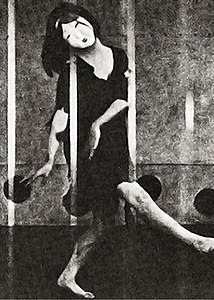One side of the madness
| Movie | |
|---|---|
| German title | One side of the madness |
| Original title | 狂 っ た 一頁 Kurutta Ippēji |
| Country of production | Japan |
| original language | Japanese |
| Publishing year | 1926 |
| length | 78 minutes |
| Age rating | FSK 12 |
| Rod | |
| Director | Kinugasa Teinosuke |
| script | Kinugasa Teinosuke, Kawabata Yasunari , Sawada Banko , Inuzuka Minoru |
| occupation | |
A page of madness ( Jap. 狂った一頁 , Kurutta ippēji , dt. "A crazed side") is a silent movie of the Japanese director Teinosuke Kinugasa , from the year 1926 . The film was almost 50 years as lost until it was rediscovered in Kinugasa Warehouse 1,971th The film is the product of an avant-garde group of Japanese artists called Shinkankaku-ha (style of new perception) who sought to overcome naturalistic representation. Kawabata Yasunari , who received the Nobel Prize in Literature in 1968 , is named as the author of the story in the opening credits. He is often named as the screenwriter of the film and a version of the script is part of the complete output of his works. Today, however, the script is viewed as a collaboration between Kawabata, Kinugasa, Sawada Banko, and Inuzuka Minoru.
action
The film is set in a mental institution. Although it has been cut into an increasingly disturbing vortex of images, the film incoherently tells the story of the caretaker of the institution in which his wife is housed as a patient. One day her daughter shows up to tell her mother about their engagement. This sets in motion a multitude of storylines and flashbacks that gradually come together to form the family history, explaining, for example, why the mother was admitted and the daughter knows nothing about her father's caretaker job.
reception
The film has no subtitles, which makes it more difficult for today's viewers to understand. In the film copy that is preserved today, almost a third of the theatrical version from 1926 is missing. In Japan in the 1920s, film performances included musical background as well as the accompanying narration by a benshi ( 弁 士 ). A famous representative of the Benshi was Tokugawa Musei , who accompanied the film at the Musashinokan cinema in Shinjuku in Tokyo .
swell
- William O. Gardner: New Perceptions: Kinugasa Teinosuke's Films and Japanese Modernism . In: Cinema Journal . 43, No. 3, Spring 2004, pp. 59-78.
- Aaron Gerow: A Page of Madness: Cinema and Modernity in 1920s Japan . Center for Japanese Studies, University of Michigan, 2008, ISBN 978-1-929280-51-3 .
- Mariann Lewinsky: A crazy side: silent films and cinematic avant-garde in Japan . Chronos, 1997, ISBN 3-905312-28-X .
Web links
- Film review , world online
- Movie review , BBC online (Engl.)
- Jasper Sharp: A Page of Madness . In: www.midnighteye.com . March 7, 2002. Retrieved April 17, 2007. (Eng.)
- A page of madness in the Internet Movie Database (English)
